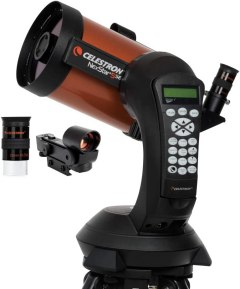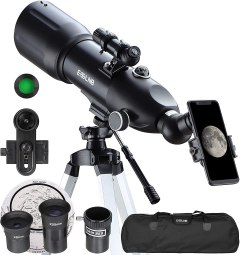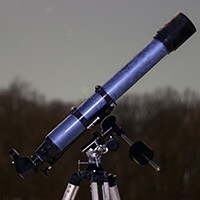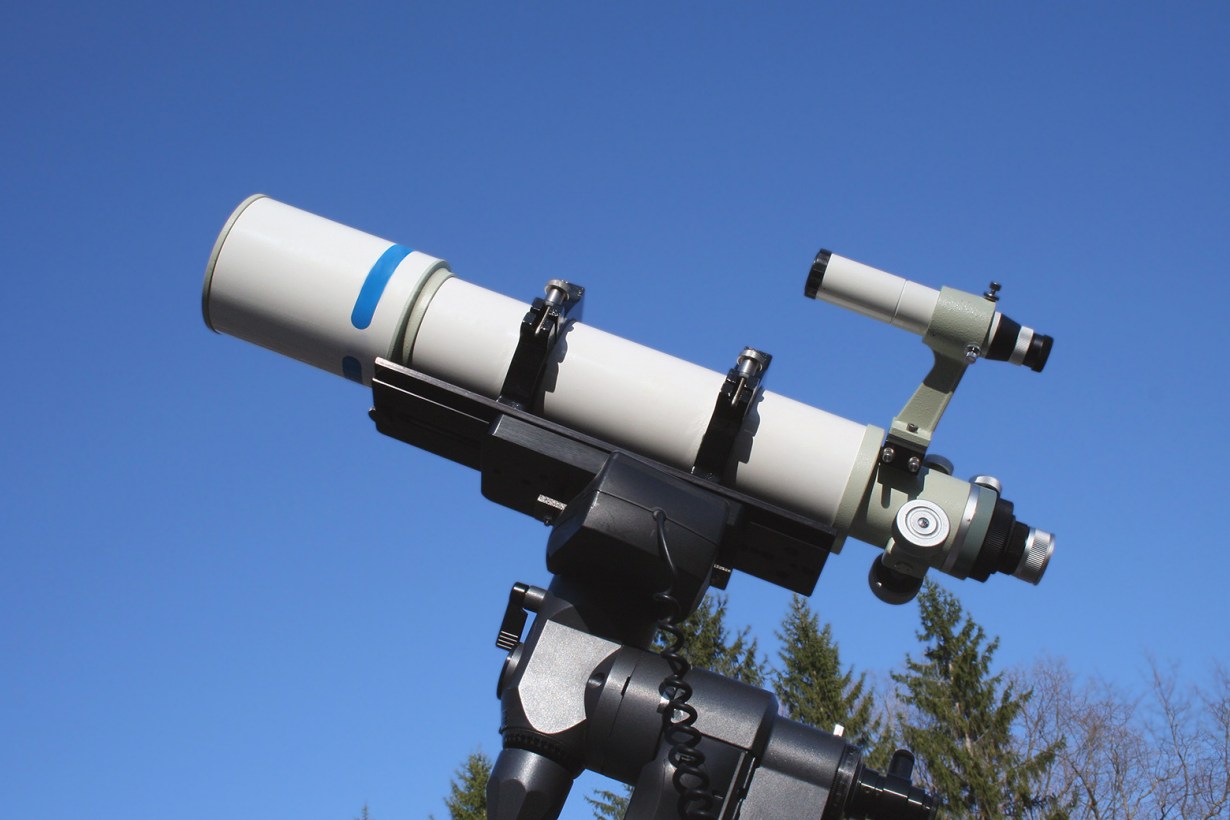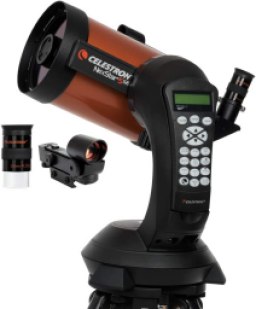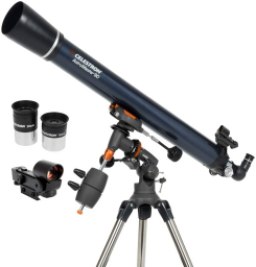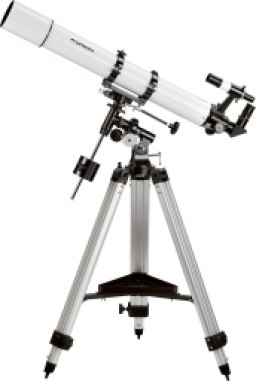Buying guide for best refractor telescopes
A refracting or refractor telescope is the quintessential telescope that comes to mind when you think of a telescope: a long sealed tube with a large lens at one end and a small lens at the other. Refractor telescopes use lenses to collect and focus the light from an observed object to the viewer’s eye. Even a basic one can reveal the wonders of the night sky to amateur astronomers if it’s set up and used correctly.
The refractor telescope was invented in 1608 in what is now the Netherlands, and its use quickly spread throughout Europe. Within a year of its invention, a simple homemade refractor telescope allowed Italian astronomer Galileo Galilei to make the discoveries that changed the world.
Refractor telescopes remain some of the most popular telescopes available. If you’re looking to buy one, there are a lot of competing models, each trying to outdo each other in terms of magnification and specifications. A good buying guide and recommendations can help focus your search.
How to buy the best refractor telescope
Refractor, reflector, or catadioptric?
A refractor is one of three types of telescope, the others being the reflector and the compound or catadioptric (also known as the Cassegrain).
- Refractors use lenses to collect and focus light.
- Reflectors, as the name implies, use a mirror.
- Compound or catadioptric telescopes use a combination of mirrors and lenses.
Due to their sealed construction, a refractor telescope is usually easier to set up and maintain than other types. Having a lens also allows it to collect more light than a similarly sized mirror with the same aperture. Finally, unlike the other telescopes, refractors are good for terrestrial viewing.
Aperture
The aperture is the single most important specification to look for when buying a telescope. A telescope’s aperture is the size of the optical element that captures light.
In a refractor telescope, this element is a convex lens called the objective. The larger the aperture, the wider the objective and the more light a refractor can collect. The more light collected, the clearer, sharper, and farther you can see.
A good starting aperture for a refractor telescope is 70 millimeters (mm), suitable for looking at the Moon and the planets in our solar system. Larger apertures of 90 mm and more enable you to see clearer, brighter images and more distant objects.
Focal length
The other important specification in a telescope is the focal length, which is the distance light travels from the objective to the focal point, the point where the light beams meet. A longer focal length increases the maximum useful magnification. A shorter focal length offers a wider field of view.
Due to the design of a refractor telescope, its focal length is usually close to the length of its tube, but not always.
The size of a refractor telescope’s aperture has almost no bearing on its magnification except that a bigger aperture means more light and detail. A small aperture with big magnification just shows you a dim, blurry image.
STAFF
BestReviews
Features to look for in a refractor telescope
Eyepiece
The eyepiece is where you look into the telescope. It has its own lens and focal length that works with the telescope’s focal length to achieve magnification. Many refractor telescopes come with at least two eyepieces.
Eyepieces are removable, so you can swap one out for another for different needs. An eyepiece of 25 mm offers a wider angle than one of 10 mm and is more suitable for looking at stars and galaxies. A 10 mm eyepiece has a narrower angle and higher magnification, which is suitable for looking at planets.
Magnification
Maximum useful magnification: In a refractor telescope, this is usually about twice its aperture in millimeters, or 50 times its aperture in inches. A refractor with a 70 mm aperture, 400 mm focal length, and 10 mm eyepiece has a maximum useful magnification of around 140x.
Actual magnification: This is the focal length divided by the focal length of the eyepiece. The same example above has an actual magnification of 40x.
Be careful. Some retailers advertise high magnifications beyond a telescope’s specifications that would only result in dim, blurry images. Magnifications like 300x are generally marketing hype.
Mount
The part the telescope rests on is called the mount, and it allows the telescope to swivel and rotate. Most refractor telescopes come with either an alt-azimuth or equatorial mount.
Alt-azimuth mount: This allows you to manually point the telescope up and down (altitude) and left or right (azimuth). Alt-azimuth mounts are easier to point in any given direction but can be less accurate than equatorial mounts.
Equatorial mount: This aligns one axis to Earth’s and allows you to track a spot in the sky as Earth rotates. Equatorial mounts tend to be more precise and can be motorized and computer-guided.
Finder
A finder usually comes with every refractor telescope. It comes as either a finderscope, which looks like a miniature refractor, or a red-dot finder, which projects a circle or dot of red light onto a clear window. You can buy different finders for your telescope, so you don’t have to rely on the one that came with it.
Stand
A tripod or other type of stand connects to the telescope mount. Stability is key in a telescope stand. A fine telescope with expensive optics will be all but useless if you set it on a wobbly, shaky, or unstable mount and stand.
Tabletop: Many smaller, cheaper telescopes have a desktop or tabletop stand, which requires some sort of raised surface for comfortable viewing.
Full-size: Most telescopes boast a full-size or extendable tripod, which rests on the ground and adjusts to your viewing height.
DID YOU KNOW?
Galileo was the first person to turn a telescope skyward to view the heavens. He built his tabletop refractor telescope through trial and error.
STAFF
BestReviews
What accessories go with a refractor telescope?
Eyepieces
Having more eyepieces than just those that come with your telescope expands the kinds of objects you can see. You can get eyepieces with focal lengths and magnifications that approach your telescope’s useful maximum. You can also find specialized eyepieces with illumination, eyepieces that make it easier to aim, or eyepieces that correct the image even more.
Barlow lens
A Barlow lens effectively increases the possible magnification of an image by multiplying the focal length of the telescope. Practically speaking, adding a Barlow lens doubles the number of eyepieces in your collection. Barlow lenses are measured in magnification, such as a 2x Barlow, 3x Barlow, and so on.
Filters
A filter reduces the amount of light that enters your telescope, allowing you to see greater detail and contrast. Two of the more popular filters are lunar and solar. Lunar filters attach under the eyepiece and reduce the glare of a full or bright Moon, bringing clarity to its craters and terrain. Solar filters allow you to view the Sun, such as when watching a solar eclipse. The safest solar filters cover the aperture in front of the objective.
Camera and smartphone adapters
Camera and smartphone adapters allow you to use your telescope for astrophotography. Camera adapters take the place of the eyepiece and allow you to securely screw the camera body via a T-ring, essentially making the whole telescope an extended camera lens. Smartphone adapters attach to the eyepiece and feature sturdy grips or frames that hold the smartphone’s camera in place. Special astrophotography apps are available for smartphones.
Telescope bag
If you’re chasing a dark sky far from where you live, you need not only a telescope but also a telescope bag. A good bag has room for the telescope, mount, tripod or stand, and accessories, preferably padded with separate compartments to keep delicate optics and accessories protected.
How much do refractor telescopes cost?
Inexpensive
Basic refractor telescopes cost less than $100. These tend to feature smaller apertures, lower focal lengths, and lower-power eyepieces. They may have basic screw mounts and short and wobbly tripods, and they may not have many accessories. They’re designed for kids and beginners, but keep in mind that a poor-quality telescope can be discouraging to a budding astronomer.
Mid-range
Mid-range refractor telescopes cost between $100 and $500. These are solidly built scopes with larger apertures, higher-quality objectives, longer focal lengths, usually more than two eyepieces, and smooth, stable mounts. Some also come with astronomy software and guides. They come from well-established, well-regarded brands and often offer extras like telescope bags, Barlow lenses, red-dot finders, and lunar filters.
Expensive
Above $500 you’ll find powerful refractors for backyard astronomers, serious hobbyists, and telescope enthusiasts. These have big apertures, complex multi-lens setups, computerized mechanized mounts, and more.
A telescope’s focal ratio is its focal length divided by its aperture. Focal ratios are expressed as f/#. Like focal length, low focal ratios like f/4 offer wider views, while high focal ratios like f/15 offer higher magnification. Ratios between f/5 and f/8 are a good compromise.
STAFF
BestReviews
Tips
- Use a good lens cleaner. Use one made for camera lenses to keep the lenses of your refractor telescope clean and undamaged.
- Look for a focuser with smooth action that holds its position accurately. A telescope’s focus is controlled by its focuser, usually a knob near the eyepiece.You don’t want one that moves jerkily or can’t keep its setting when you let go.
- Think about the portability of your telescope. Most people live near light pollution or other artificial nocturnal illumination. To get truly dark skies often means traveling far away from population centers. Consider how heavy your telescope is and how easy it is to transport, assemble, and disassemble.
- Consider whether you’ll use your telescope indoors or outdoors. Moving a fully assembled telescope can be cumbersome.
FAQ
Q. What are the disadvantages of a refractor telescope?
A. There are some disadvantages to a refractor telescope compared to reflectors and catadioptrics. False color, or chromatic aberration, occurs due to the refraction of light through a lens. Different colors and wavelengths of light bend slightly differently, creating a halo around some objects. Special lens setups called achromatic and apochromatic counteract false color, but they can be quite expensive. Look for ED refractor telescopes, which are essentially affordable apochromatics, if avoiding false color is paramount to you. Refractors also get more expensive and unwieldy as they go up in power compared to reflectors due to the cost of lenses versus mirrors and the size of tubes with long focal lengths.
Q. What are doublet and triplet refractor telescopes?
A. Doublet and triplet refractors have two or three lenses in their objective. They’re usually achromatic or apochromatic and tend to have sharper, clearer images than single-lens refractor telescopes. They also cost more.
Q. What’s the difference between coated and uncoated lenses?
A. Coating in telescopes refers to treating the optics to reduce reflection. In refractor telescopes, this allows more light to pass through the lenses. Coating makes a lens look dark. In fully coated refractors, all the optics are coated as opposed to just one or both sides of the objective.
Q. Does a refractor telescope invert the image?
A. A refractor telescope produces an upside-down image due to the nature of light refraction. Refractors whose eyepiece mounts at an angle to the tube use an element called a star diagonal to redirect the image, which also turns the image right side up but mirrored right to left. To reverse the mirroring, you need what’s called a prism diagonal as well, which isn’t usually included with a telescope.
Q. Can I see Uranus, Neptune, or Pluto with a refractor telescope?
A. If you know where to look, it’s possible to see both Uranus and Neptune as tiny colored points or discs through a refractor telescope with at least a 70 to 100 mm aperture and high magnification. To see Pluto, you need very dark skies and a 200 mm (8-inch) aperture or larger refractor telescope.


